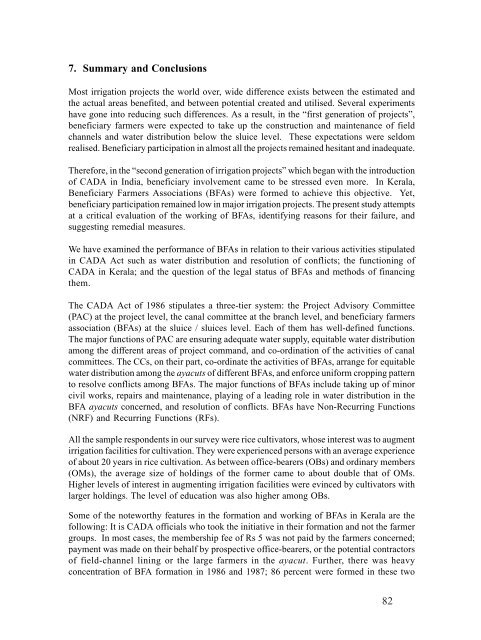Beneficiary Participation in Irrigation Water Management: The Kerala
Beneficiary Participation in Irrigation Water Management: The Kerala
Beneficiary Participation in Irrigation Water Management: The Kerala
You also want an ePaper? Increase the reach of your titles
YUMPU automatically turns print PDFs into web optimized ePapers that Google loves.
7. Summary and Conclusions<br />
Most irrigation projects the world over, wide difference exists between the estimated and<br />
the actual areas benefited, and between potential created and utilised. Several experiments<br />
have gone <strong>in</strong>to reduc<strong>in</strong>g such differences. As a result, <strong>in</strong> the “first generation of projects”,<br />
beneficiary farmers were expected to take up the construction and ma<strong>in</strong>tenance of field<br />
channels and water distribution below the sluice level. <strong>The</strong>se expectations were seldom<br />
realised. <strong>Beneficiary</strong> participation <strong>in</strong> almost all the projects rema<strong>in</strong>ed hesitant and <strong>in</strong>adequate.<br />
<strong>The</strong>refore, <strong>in</strong> the “second generation of irrigation projects” which began with the <strong>in</strong>troduction<br />
of CADA <strong>in</strong> India, beneficiary <strong>in</strong>volvement came to be stressed even more. In <strong>Kerala</strong>,<br />
<strong>Beneficiary</strong> Farmers Associations (BFAs) were formed to achieve this objective. Yet,<br />
beneficiary participation rema<strong>in</strong>ed low <strong>in</strong> major irrigation projects. <strong>The</strong> present study attempts<br />
at a critical evaluation of the work<strong>in</strong>g of BFAs, identify<strong>in</strong>g reasons for their failure, and<br />
suggest<strong>in</strong>g remedial measures.<br />
We have exam<strong>in</strong>ed the performance of BFAs <strong>in</strong> relation to their various activities stipulated<br />
<strong>in</strong> CADA Act such as water distribution and resolution of conflicts; the function<strong>in</strong>g of<br />
CADA <strong>in</strong> <strong>Kerala</strong>; and the question of the legal status of BFAs and methods of f<strong>in</strong>anc<strong>in</strong>g<br />
them.<br />
<strong>The</strong> CADA Act of 1986 stipulates a three-tier system: the Project Advisory Committee<br />
(PAC) at the project level, the canal committee at the branch level, and beneficiary farmers<br />
association (BFAs) at the sluice / sluices level. Each of them has well-def<strong>in</strong>ed functions.<br />
<strong>The</strong> major functions of PAC are ensur<strong>in</strong>g adequate water supply, equitable water distribution<br />
among the different areas of project command, and co-ord<strong>in</strong>ation of the activities of canal<br />
committees. <strong>The</strong> CCs, on their part, co-ord<strong>in</strong>ate the activities of BFAs, arrange for equitable<br />
water distribution among the ayacuts of different BFAs, and enforce uniform cropp<strong>in</strong>g pattern<br />
to resolve conflicts among BFAs. <strong>The</strong> major functions of BFAs <strong>in</strong>clude tak<strong>in</strong>g up of m<strong>in</strong>or<br />
civil works, repairs and ma<strong>in</strong>tenance, play<strong>in</strong>g of a lead<strong>in</strong>g role <strong>in</strong> water distribution <strong>in</strong> the<br />
BFA ayacuts concerned, and resolution of conflicts. BFAs have Non-Recurr<strong>in</strong>g Functions<br />
(NRF) and Recurr<strong>in</strong>g Functions (RFs).<br />
All the sample respondents <strong>in</strong> our survey were rice cultivators, whose <strong>in</strong>terest was to augment<br />
irrigation facilities for cultivation. <strong>The</strong>y were experienced persons with an average experience<br />
of about 20 years <strong>in</strong> rice cultivation. As between office-bearers (OBs) and ord<strong>in</strong>ary members<br />
(OMs), the average size of hold<strong>in</strong>gs of the former came to about double that of OMs.<br />
Higher levels of <strong>in</strong>terest <strong>in</strong> augment<strong>in</strong>g irrigation facilities were ev<strong>in</strong>ced by cultivators with<br />
larger hold<strong>in</strong>gs. <strong>The</strong> level of education was also higher among OBs.<br />
Some of the noteworthy features <strong>in</strong> the formation and work<strong>in</strong>g of BFAs <strong>in</strong> <strong>Kerala</strong> are the<br />
follow<strong>in</strong>g: It is CADA officials who took the <strong>in</strong>itiative <strong>in</strong> their formation and not the farmer<br />
groups. In most cases, the membership fee of Rs 5 was not paid by the farmers concerned;<br />
payment was made on their behalf by prospective office-bearers, or the potential contractors<br />
of field-channel l<strong>in</strong><strong>in</strong>g or the large farmers <strong>in</strong> the ayacut. Further, there was heavy<br />
concentration of BFA formation <strong>in</strong> 1986 and 1987; 86 percent were formed <strong>in</strong> these two<br />
82










